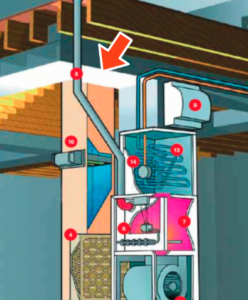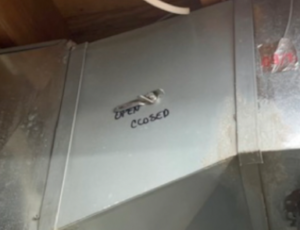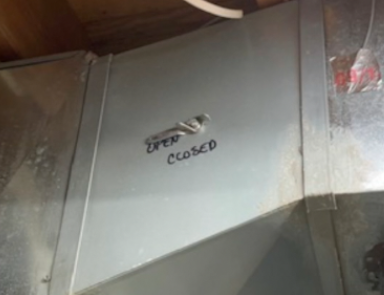Do you have rooms that are too hot or too cold?
Recently we received a question from our “ask an expert” page on our website. Yevette asked: “I was wondering if you could tell me how to switch my dampers now that we have the heater on because it’s set for summer right now, and is pushing all of the hot air upstairs and it is stifling up there.” Yes, we can help you with some easy tips on how to adjust dampers plus how to tell if your dampers are open or closed.
Where are HVAC dampers located?
 Typically in most homes, your HVAC dampers are located in the main supply trunks. The supply trunks are the parts of the ductwork that are blowing warm air or cold air depending on the season. How many dampers are you looking for? Every house is different. Some homes have no dampers at all. Hopefully most homes have a damper in each one of the supply ducts. Your home may have a supply duct go to the right and you might have one go to the left off of your furnace. You’ll also typically have a damper in the supply duct going to your upstairs. If you have exposed ductwork, look at all the runs and check which ones have dampers. Some homes have dampers in every run, which is great for air balancing.
Typically in most homes, your HVAC dampers are located in the main supply trunks. The supply trunks are the parts of the ductwork that are blowing warm air or cold air depending on the season. How many dampers are you looking for? Every house is different. Some homes have no dampers at all. Hopefully most homes have a damper in each one of the supply ducts. Your home may have a supply duct go to the right and you might have one go to the left off of your furnace. You’ll also typically have a damper in the supply duct going to your upstairs. If you have exposed ductwork, look at all the runs and check which ones have dampers. Some homes have dampers in every run, which is great for air balancing.
How to tell if HVAC dampers are open or closed?
Dampers are made of sheet metal. These sheet metal dampers have a little wing nut on them. The very center of the bolt that goes through that wing nut has a flat spot on it and that tells you the position of the damper. When you look at it and it’s been smashed in a certain direction, that means the damper is in that position. As you rotate it you visualize that a damper is attached to the part you can turn. It moves in the same position as the direction you turn the wing nut. If you look at it and it is horizontal that means it is open. If you turn it at an angle it will cut down the amount of air going through the duct.
 When you loosen the wing nut to adjust the damper, you may need a pair of pliers to loosen it. Turn it, then hold it there and tighten the nut back down to keep the damper in position.
When you loosen the wing nut to adjust the damper, you may need a pair of pliers to loosen it. Turn it, then hold it there and tighten the nut back down to keep the damper in position.
To summarize, if you are looking at ductwork going horizontal over your head and the little wing is in a horizontal position that means it’s open. If you are looking at a duct that is coming off the furnace and going straight up like it is going to the upstairs, and the wing is in the same direction as the duct, it is open. If the wing is in the opposite or vertical position to the ductwork, then the damper is closed.
When should you adjust a balancing damper?
You’ll notice a need to adjust your dampers when you are changing seasons. When the temperatures get cold enough that you turn on the furnace, you will notice your upstairs feeling too hot. Personally I wouldn’t adjust the dampers until you are routinely using either the furnace or air conditioner so you can better understand where you want the conditioned air to go.
How to test if your dampers are open or closed?
If you have someone to help you, an easy way to check if the dampers are open or closed is to get someone to go upstairs and place their hand over each vent. By placing your hand over the vent in a bedroom, you can test each damper to make sure it is open or closed. It takes some teamwork, but it is a great and easy way to get maximum comfort for hot spots and cold spots in your home.
HVAC Damper Open Or Closed In Summer/Winter
In most homes, dampers going to the upstairs are open in the summer and closed in the winter. By closing the dampers to the upstairs in the winter, it allows for the heat to rise naturally after first being introduced into the lower levels of the home. In the summer, the downstairs is naturally cooler and most people complain of hot bedrooms. Opening the dampers to the upstairs and closing as much air to the downstairs as possible allows maximum cool air to go to the bedrooms in the summertime.
Still have hot spots or cold spots after adjusting dampers?
Dampers are great, but they may not be enough to completely end hot spots or cold spots in your home. There are several reasons you may still have air balancing issues.
- Poor air flow. Have you changed your filter recently? Dirty air filters can block necessary air flow to keep your home comfortable.
- Blocked air vents. Make sure you don’t have furniture or personal items blocking the vents where you are feeling hot or cold spots.
- Air leaks in your duct work. Most homes leak a significant amount of air through unsealed portions of their ductwork. Ductsealing is a great option for fixing hot spots and cold spots in your home.

